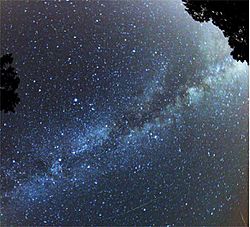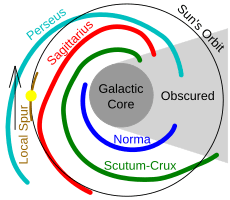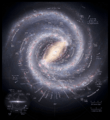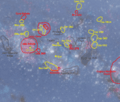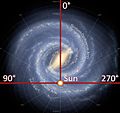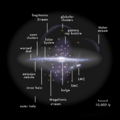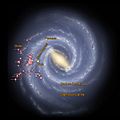Milky Way facts for kids
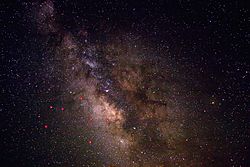
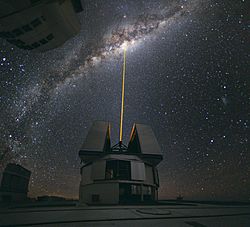
The Milky Way is our home galaxy. It contains over 200 billion stars, including our Sun.
The Milky Way has a diameter of 100,000 light years, and is a barred spiral galaxy. The discovery of the Milky Way goes back to the Ancient Greek philosopher Democritus. The Milky Way has three main parts: a disk, in which the Solar System resides, a bulge at the core, and an all encompassing halo.
This galaxy belongs to the Local Group of three large galaxies and over 50 smaller galaxies. The Milky Way is one of the largest galaxies in the group, second to the Andromeda Galaxy. Milky Way's closest neighbour is Canis Major Dwarf, which is about 25,000 light years away from the Earth. The Andromeda Galaxy moves towards the Milky Way Galaxy, and will meet it in about 3.75 billion years. Andromeda Galaxy moves with a speed of about 1,800 kilometres per minute.
Contents
Size
The stellar disk of the Milky Way Galaxy is approximately 100,000 light-years (9×1017 km) in diameter, and is considered to be, on average, about 1000 light years thick.
It is estimated to contain at least 200 billion stars and possibly up to 400 billion stars. The figure depends on the number of very low-mass, or dwarf stars, which are hard to detect, especially more than 300 light years from our sun. Therefore, present estimates of the total number are uncertain. This can be compared to the one trillion (1012) stars of the neighbouring Andromeda Galaxy.
The stellar disc of the Milky Way does not have a sharp edge, a radius beyond which there are no stars. Rather, the number of stars drops smoothly with distance from the centre of the Galaxy. Beyond a radius of about 40,000 light years, the number of stars drops much faster, for reasons that are not understood.
Extending beyond the stellar disk is a much thicker disk of gas. Recent observations indicate that the gaseous disk of the Milky Way has a thickness of around 12000 light years–twice the previously accepted value. As a guide to the relative physical scale of the Milky Way, if the Solar System out to the orbit of Pluto were reduced to the size of a US quarter (about an inch or 25 mm in diameter), the Milky Way would have a diameter of 2,000 kilometers. At 220 kilometers per second it takes the Solar System about 240 million years to complete one orbit of the Galaxy (a galactic year).
The Galactic halo extends outward, but is limited in size by the orbits of two Milky Way satellites, the Large and the Small Magellanic Clouds, whose closest approach is at about 180,000 light years. At this distance or beyond, the orbits of most halo objects would be disrupted by the Magellanic Clouds, and the objects would likely be ejected from the vicinity of the Milky Way.
Galactic center
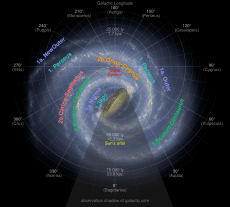
The galactic disc, which bulges outward at the galactic center, has a diameter of 70–100,000 light years.
The exact distance from the Sun to the galactic center is debated. The latest estimates give distances to the Galactic center of 25–28,000 light years.
Movement of material around the galactic center shows that it has a compact object of very large mass. The intense radio source named Sagittarius A*, thought to mark the center of the Milky Way, is now confirmed to be a supermassive black hole. Most galaxies are believed to have a supermassive black hole at their center.
The nature of the galaxy's bar is also actively debated, with estimates for its half-length and orientation spanning from 3,300–16,000 light years (short or a long bar) and 10–50 degrees. Viewed from the Andromeda Galaxy, it would be the brightest feature of our own galaxy.
Myth
In Greek mythology, Zeus places his son (the baby Heracles) whose mother was a mortal woman on Hera's breast while she is sleeping so that the baby will drink her divine milk and become immortal. However, Hera wakes up while she is breastfeeding the baby and realizes she is nursing a baby she does not know. According to Greek mythology, she then pushes the baby away and a stream of her milk sprays the night sky, making a faint band of light known as the Milky Way.
Images for kids
-
A view of the Milky Way toward the constellation Sagittarius (including the Galactic Center), as seen from a dark site with little light pollution (the Black Rock Desert, Nevada), the bright object on the lower right is Jupiter, just above Antares
-
The shape of the Milky Way as deduced from star counts by William Herschel in 1785; the Solar System was assumed near center
-
Photograph of the "Great Andromeda Nebula" from 1899, later identified as the Andromeda Galaxy
-
Map of the Milky Way Galaxy with the constellations that cross the galactic plane in each direction and the known prominent components annotated including main arms, spurs, bar, nucleus/bulge, notable nebulae and globular clusters.
-
Artistic close-up of the Orion Arm with the main features of the Radcliffe Wave and Split linear structures, and with the Solar System surrounded by the closest large scale celestial features at the surface of the Local Bubble at a distance of 400–500 light years.
-
The structure of the Milky Way is thought to be similar to this galaxy (UGC 12158 imaged by Hubble)
-
360-degree panorama view of the Milky Way (an assembled mosaic of photographs) by ESO, the galactic centre is in the middle of the view, with galactic north up
-
360-degree rendering of the Milky Way using Gaia EDR3 data showing interstellar gas, dust backlit by stars (main patches labeled in black; white labels are main bright patches of stars). Left hemisphere is facing the galactic center, right hemisphere is facing the galactic anticenter.
-
Galaxy rotation curve for the Milky Way – vertical axis is speed of rotation about the galactic center; horizontal axis is distance from the galactic center in kpcs; the sun is marked with a yellow ball; the observed curve of speed of rotation is blue; the predicted curve based upon stellar mass and gas in the Milky Way is red; scatter in observations roughly indicated by gray bars, the difference is due to dark matter
-
The Milky Way arching at a high inclination across the night sky, (this composited panorama was taken at Paranal Observatory in northern Chile), the bright object is Jupiter in the constellation Sagittarius, and the Magellanic Clouds can be seen on the left; galactic north is downward
See also
 In Spanish: Vía Láctea para niños
In Spanish: Vía Láctea para niños


